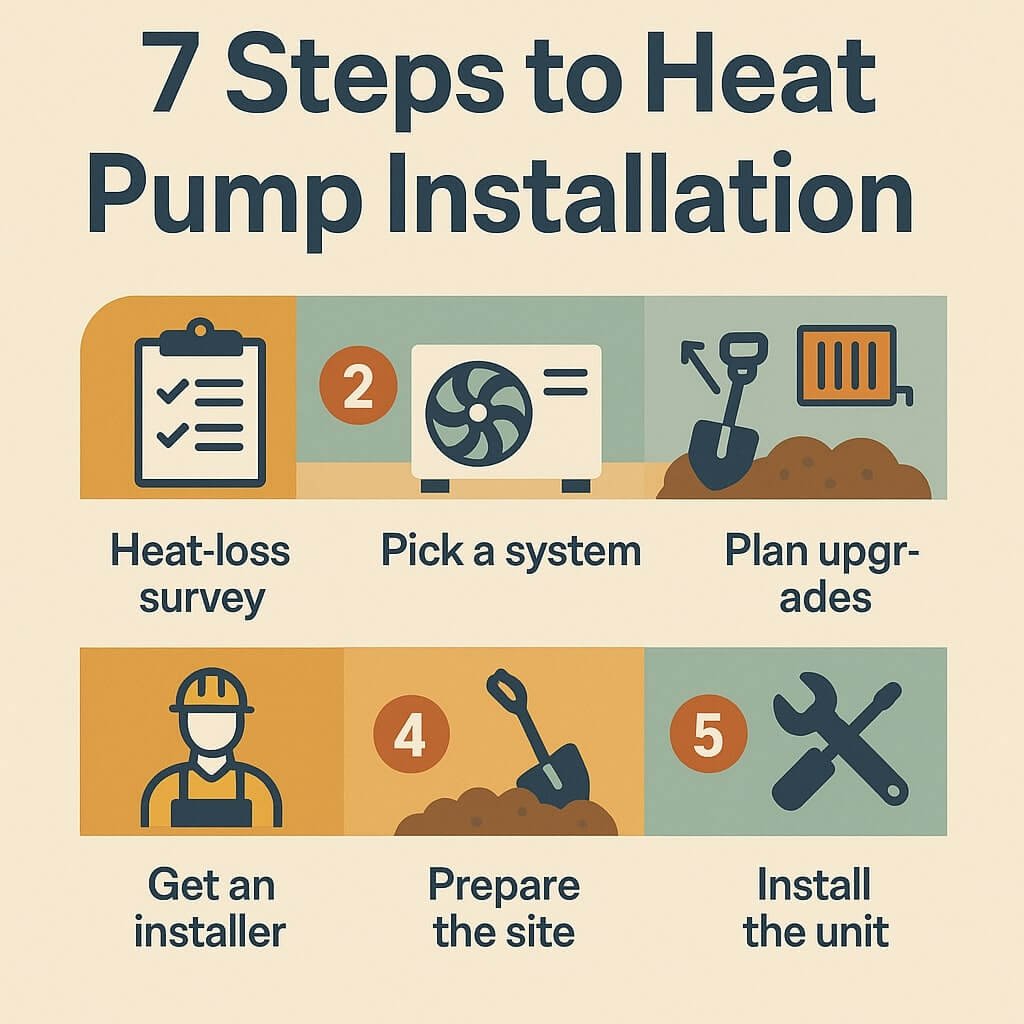Let’s be honest—central heating isn’t the most thrilling topic at the dinner table. But what if your boiler could be replaced with something whisper-quiet, future-proof, and kinder to both your wallet and the planet? That’s where the humble heat pump comes in.
Once a fringe choice for the eco-conscious, heat pumps are fast becoming the backbone of the UK’s low-carbon revolution. Government grants are now generous, the tech is more advanced, and—most importantly—you don’t need to be living in a Grand Designs house to get one installed. Whether you’re in a post-war semi, a Victorian terrace, or a new-build in Milton Keynes, there’s now a clear, practical pathway to joining the heat pump future.
So, here’s your deep dive. We’ll walk you through everything from government support and system types, to installation logistics and tariff savings. And yes, we’ll bust a few myths along the way.
Table of Contents
What Is a Heat Pump, Really?
At its core, a heat pump is a clever bit of kit that moves heat rather than making it. It extracts warmth from the outside air (even when it’s cold), compresses it, and uses that energy to warm your home and water. Kind of like a fridge—but in reverse.
There are several types, but the most common in the UK is the air-to-water heat pump, which connects to your existing radiators or underfloor heating. Ground- and water-source systems also exist, usually for homes with more outside space.
The beauty of a heat pump is its efficiency. For every unit of electricity it uses, it can produce three or even four units of heat. That’s why it’s seen as one of the most powerful tools to decarbonise home heating in Britain.
Why the Heat Pump Moment Is Now
Here’s a truth bomb: heating our homes accounts for nearly 14% of the UK’s total greenhouse gas emissions. That’s more than all domestic flights and car journeys combined. Replacing gas boilers with heat pumps is not just a smart move—it’s essential.
Luckily, the timing couldn’t be better. The Boiler Upgrade Scheme (BUS) offers homeowners in England and Wales a grant of up to £7,500 to install a heat pump. That’s nearly half the cost, making it affordable for thousands of households.
Even better, planning restrictions have eased. If your heat pump unit is under 1.5 cubic metres, you no longer need planning permission, even in high-density areas. That’s great news for anyone in a terrace or urban setting.
Meanwhile, energy prices remain high, and many Brits are eyeing up long-term solutions to protect themselves from future price hikes. A properly installed heat pump can cut heating bills significantly—especially when paired with smart tariffs and a well-insulated home.
Types of Heat Pumps: What Works Best?
1. Air-to-Water Heat Pump (Most Common)
The workhorse of British retrofits, this system draws in air, compresses it, and heats water for radiators or underfloor systems. With the latest models reaching flow temperatures of up to 80°C, you might not need to replace your radiators at all.
2. Ground-Source Heat Pump
Ideal for rural homes or those with big gardens, these systems use underground pipes to draw stable warmth from the earth. They’re super-efficient but more disruptive and costly to install.
3. Hybrid Heat Pump
Perfect for cautious switchers. These systems pair a small heat pump with your existing boiler. The pump handles most of the work, while the boiler kicks in only during high demand.
4. Air-to-Air Heat Pump
More common in commercial settings, this setup works like a reverse air-con system. It doesn’t heat water, just the air—so it’s great for open-plan spaces but less suitable for homes that rely on radiators.
Is Your Home Ready?
You might think heat pumps are only for new-builds. Not true.
A study from the University of Birmingham found that two-thirds of British homes could switch to a heat pump without upgrading their radiators. That’s because modern pumps can reach higher temperatures, and older houses often already have generously-sized rads.
Still, before you jump in, it’s essential to get a whole-house heat loss survey. This calculation will help determine:
- The correct size of your heat pump
- Whether your insulation is up to scratch
- If your radiators can deliver enough heat at lower flow temps
The key is getting a professional, room-by-room assessment. Don’t let an installer size your system based on your old gas boiler’s rating—it doesn’t translate.
The Installation Process, Demystified
A typical heat pump install takes about 3 to 5 days. Here’s how it breaks down:
Day 1: Groundworks—setting the unit’s base, laying a condensate drain, possibly trenching for pipework.
Day 2: Plumbing and connection to your radiators or underfloor system.
Day 3: Electrical hookup, smart thermostat configuration.
Day 4–5: System testing, balancing, and commissioning.
Your installer should also handle all paperwork for the Boiler Upgrade Scheme and leave you with an MCS handover pack—essential if you plan to sell your home in the future.

Understanding the Costs
On average, an air-source heat pump installation costs between £10,000 and £14,000, depending on property size and complexity. The £7,500 government grant brings that down to a more manageable level.
If your home needs significant radiator upgrades or electrical upgrades (like a new consumer unit), costs can rise. But with careful planning, most homes can make the switch with minimal disruption.
Bonus: Once installed, you may qualify for lower-cost electricity tariffs (like Octopus’s Agile or Cosy tariffs), reducing ongoing costs even further.
Real-World Energy Savings
The efficiency of a heat pump is where it truly shines. A gas boiler might be 85–90% efficient, but a heat pump routinely achieves 300–400% efficiency.
That translates into:
- 30–40% lower heating bills for well-insulated homes
- Up to 80% lower carbon emissions
- Future-proofing against fossil fuel price hikes
Pair your pump with solar panels and a thermal battery, and you’re getting very close to net-zero living.
The Smart Home Advantage
Smart controls make a big difference. Modern heat pumps can be programmed to:
- Run during off-peak electricity hours
- Pre-heat your home before peak demand
- Automatically adjust based on outside temperature
- Report performance and diagnostics remotely
This means better comfort, fewer surprises, and lower costs. Many systems also integrate with apps, so you can tweak settings from your phone or laptop—even while on holiday.
The Role of Electrification
As the UK’s energy grid gets greener, switching to electric heating makes more sense every year. By 2030, over 70% of UK electricity is expected to come from renewable sources.
That means every kilowatt-hour used by your heat pump is increasingly climate-friendly, while gas boilers remain tethered to a fossil-fuel future.
In short: every year you wait, a heat pump becomes a better deal for both your wallet and the planet.
Grants, Loans, and Green Financing
The Boiler Upgrade Scheme is currently the main incentive—up to £7,500 off your installation, paid directly to your installer. No admin stress.
But other schemes are emerging too:
- Energy Company Obligation (ECO4) for lower-income households
- On-bill financing trials, where costs are repaid through your energy bill
- Green mortgage discounts for homes with upgraded EPC ratings
Always check with your installer—many offer help applying for these incentives or provide their own flexible payment plans.
Choosing the Right Installer
This is where the rubber hits the road. A poor install leads to poor performance. Always choose:
- MCS-certified installers (required for the grant)
- A contractor with good reviews and visible past projects
- Companies willing to do a full heat-loss survey
- Teams who understand older UK homes—not just new-builds
You can check credentials at www.mcscertified.com.
Common Myths (and the Truth)
“They don’t work in cold weather.”
Modern systems work down to –15°C. The UK rarely sees temperatures that low.
“You need to replace all your radiators.”
Often false. Many homes are already suitable with minimal tweaks.
“They’re too expensive.”
Not with the current grant. Prices are now comparable to gas boilers—sometimes even cheaper over a 10-year run.
“They’re noisy.”
New models are whisper-quiet. The outdoor unit is usually quieter than a fridge.
Future-Proofing: What’s Coming Next
Technology keeps improving. Over the next few years, expect:
- More compact units for flats and terraced homes
- Higher-efficiency refrigerants with lower climate impact
- AI-driven controls that learn your habits
- Thermal batteries that fit inside a kitchen cupboard
- Wider tariff options with real-time pricing
In short: today’s heat pump is already excellent, but tomorrow’s will be even better.
Your Heat Pump Checklist
Before you get started, make sure to:
- Book a full heat-loss survey
- Apply for the Boiler Upgrade Scheme early
- Review your radiators (but don’t panic)
- Choose a smart thermostat system
- Ask about electrical upgrades
- Get multiple quotes
- Check MCS & TrustMark credentials
- Keep your handover pack safe (it’ll help when you sell)
A Warm Welcome to the Future
Installing a heat pump isn’t just an upgrade—it’s a statement. It says you care about your comfort, your energy bills, and the world you’re passing on to future generations. It’s a choice that pays off not just next winter, but for the next two decades.
So whether you’re motivated by saving money, going green, or just escaping the tyranny of your gas bill, the path is clearer than ever.
Ask the questions. Run the numbers. Get the survey. Then take the leap.
Your future self—and your future home—will thank you for it.


